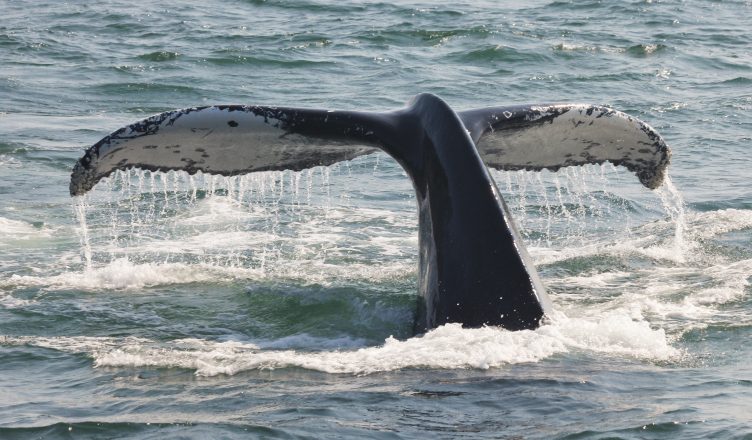Plastic pollution in the ocean is doing much more than cluttering our beaches and collecting in gyres. It is affecting individual animals, from the tiniest zooplankton to the largest whales, in their environment and inside their bodies. So what are the ways plastics affect whales and what can we do to help?
Entanglement
Whales can become physically entangled in plastic in the ocean, usually in the form of fishing nets and rope. Whale and Dolphin Conservation, a nonprofit organization with a branch in Plymouth, MA, published a recent article providing insight into cases of entanglement of North Atlantic right whales. Reports show that most entanglements are due to active fishing gear that is still in use, rather than abandoned or lost gear as is commonly believed1. In addition to surface injuries caused by entangling debris, whales can suffer from extreme energy exertion needed to travel with the burden of debris dragging behind them, and these effects can sometimes be lethal2. Researchers in New England and beyond are currently researching new fishing technologies to prevent entanglements, including ropeless traps3.
Ingestion
Plastic may be ingested by whales mistakenly while feeding on prey, or may enter their digestive system from inside of prey that has previously fed on plastic. In 2018, a sperm whale stranded in Indonesia and its necropsy revealed that it had ingested over 13 pounds of plastic, including bags and flip-flops4. Even the deep-diving species True’s beaked whales have been found with plastic in their stomachs after stranding on the beach in Ireland5. Microplastics, plastic pieces of 5mm or less, are of particular concern for baleen whales, as these giant creatures can end up ingesting the tiny plastic along with krill or other prey while filter feeding6.
Contamination & Bioaccumulation
Ocean plastic has been found to be an excellent surface for chemicals known as persistent organic pollutants (POPs) such as DDT to cling to, after entering the water as runoff, spills, or other waste. These pollutants can enter a whale’s body when the plastic is ingested and are sometimes stored within their blubber8. Through bioaccumulation, in which a predator’s body processes or stores pollutants from multiple prey, species that are at the top of the food chain are the most likely to accumulate the highest amounts of these chemicals. POPs have been found in humpback whales, sperm whales, pilot whales, and fin whales9.
What Can You Do to Help?
Eliminating or reducing the use of plastics, especially single-use plastic, in your daily life is a critical step in reducing marine debris. The ways that the world processes recyclables are changing, and one of our best preventions against marine debris is choosing not to purchase plastic to begin with. To take further action to rid our seas of marine debris, you can:
- Join us for our monthly beach cleanup
- Schedule a cleanup for your group of 10 or more
- Consider adopting a beach
- Volunteer for our microplastics research program
References:
- Asmutis-Silvia, Regina & Barco, Susan & Cole, Timothy & Henry, Allison & Johnson, Amanda & Knowlton, Amy & Landry, Scott & Mattila, David & Moore, Michael & Robbins, Jooke & Van der Hoop, Julie. (2016). Rebuttal to published article “A review of ghost gear entanglement amongst marine mammals, reptiles and elasmobranchs” by M. Stelfox, J. Hudgins, and M. Sweet. Marine Pollution Bulletin. 117. 10.1016/j.marpolbul.2016.11.052.
- Julie M. van der Hoop, Peter Corkeron, Allison G. Henry, Amy R. Knowlton, Michael J. Moore, Predicting lethal entanglements as a consequence of drag from fishing gear, Marine Pollution Bulletin, Volume 115, Issues 1–2, 2017, Pages 91-104, ISSN 0025-326X, https://doi.org/10.1016/j.marpolbul.2016.11.060.
- Baumgartner, M., Moore, M., Kraus, S., Knowlton, A., & Werner, T. (2018). Overcoming Development, Regulatory and Funding Challenges for Ropeless Fishing to Reduce Whale Entanglement in the US and Canada.
- https://www.nationalgeographic.com/environment/2018/11/dead-sperm-whale-filled-with-plastic-trash-indonesia/
- Amy L. Lusher, Gema Hernandez-Milian, Joanne O’Brien, Simon Berrow, Ian O’Connor, Rick Officer, Microplastic and macroplastic ingestion by a deep diving, oceanic cetacean: The True’s beaked whale Mesoplodon mirus, Environmental Pollution, Volume 199, 2015, Pages 185-191, ISSN 0269-7491, https://doi.org/10.1016/j.envpol.2015.01.023.
- Besseling, E.M. Foekema, J.A. Van Franeker, M.F. Leopold, S. Kühn, E.L. Bravo Rebolledo, E. Heße, L. Mielke, J. IJzer, P. Kamminga, A.A. Koelmans, Microplastic in a macro filter feeder: Humpback whale Megaptera novaeangliae, Marine Pollution Bulletin, Volume 95, Issue 1, 2015, Pages 248-252, ISSN 0025-326X, https://doi.org/10.1016/j.marpolbul.2015.04.007.
- Besseling, E.M. Foekema, J.A. Van Franeker, M.F. Leopold, S. Kühn, E.L. Bravo Rebolledo, E. Heße, L. Mielke, J. IJzer, P. Kamminga, A.A. Koelmans, Microplastic in a macro filter feeder: Humpback whale Megaptera novaeangliae, Marine Pollution Bulletin, Volume 95, Issue 1, 2015, Pages 248-252, ISSN 0025-326X, https://doi.org/10.1016/j.marpolbul.2015.04.007.
- Ryan C, McHugh B, Boyle B, McGovern E and others (2013) Levels of persistent organic pollutants in eastern North Atlantic humpback whales. Endang Species Res 22:213-223. https://doi.org/10.3354/esr00545
- Marianna Pinzone, Hélène Budzinski, Aurélie Tasciotti, Denis Ody, Gilles Lepoint, Joseph Schnitzler, George Scholl, Jean-Pierre Thomé, Nathalie Tapie, Gauthier Eppe, Krishna Das, POPs in free-ranging pilot whales, sperm whales and fin whales from the Mediterranean Sea: Influence of biological and ecological factors, Environmental Research, Volume 142, 2015, Pages 185-196, ISSN 0013-9351, https://doi.org/10.1016/j.envres.2015.06.021.






